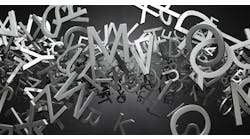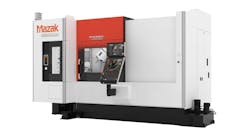Building precision into multitasking machine tools.
Part accuracies have significantly increased on multitasking machine tools. Here, the Mazak Integrex machines all part characteristics in one setup, from one datum, including angular and off-center holes.
Precision turning is grounded in a machine's thermal integrity, precision spindles, linear guideways, and correct tooling.
Multitasking machine tools, such as Mazak's Integrex 100Y, combine cutting processes while delivering high precision and repeatability. This machine has a B axis for machining angular holes on the front and backside of a workpiece.
Speed isn't everything in the machining world. Precision counts as well — especially in the area of multitasking. Fortunately, advances in component technology, coupled with new designs that eliminate heat buildup in machines, have helped today's multitasking centers deliver repeatability and precision in the millionths-of-an-inch range.
In the past 10 years, new component technologies have changed how machine tools, including multitasking centers, look and perform. One example involves headstocks that use internal permanent-magnet motors where the armature shaft is the spindle. This gets rid of belts, gears, and pulleys to significantly reduce vibration and heat. The permanent-magnet motor also eliminates the electric current in the stator, which normally generates the motor magnetism, to again minimize heat and thermal distortion.
Other advances improving machine tool performance and accuracy include high-gain servo feedback systems, cooled ballscrews, and high-precision linear guideways used for table and headstock movement. Furthermore, bearing accuracy has increased tremendously with hybrid bearings made from ceramics and the use of oil/air lubrication.
Another way builders have obtained greater machine precision is by eliminating the heat that makes machine tool components change shape. These distortions can lead to part inaccuracies.
Mazak, for instance, uses fewer hydraulic systems than it did before and more electromechanical servo-type systems for functions such as turret indexing and automatic toolchanges. These systems have fewer moving components, so, in addition to minimizing heat, they also are easier to maintain and last longer.
Builders also reduce thermal growth by running coolant through the headstock and ballscrews and by using temperature-controlled cutting fluids. This also makes the machine more stable so it can better maintain repeatability.
Software also plays a part in machine tool precision. If complex software can't be easily programmed, part precision suffers. For multi-tasking machine tools, easy-to-use, conversational software is important because of the complex geometries used in the cutting process.
With servo feedback systems and CNC controls, a manufacturer can even program around some inaccuracies in the machine tool. For instance, mechanical inaccuracies such as ballscrew pitch error can be compensated for electronically. And software algorithms can compensate for thermal changes in machine components. However, mechanical functions that affect a part's surface finish, roundness, and squareness have to be built into the machine.
With today's high speeds and feeds, precise balancing of the spindle and chuck is critical, as is the capability to hold a part in the chuck without distorting it at high spindle speeds. As for fixturing, parts have to be held tight enough to get the job done without damaging them. In many cases, workholding systems can limit both machine and tooling capabilities.
Mr. Schawe is production engineering manager for Mazak Corp., Florence, Ky.






